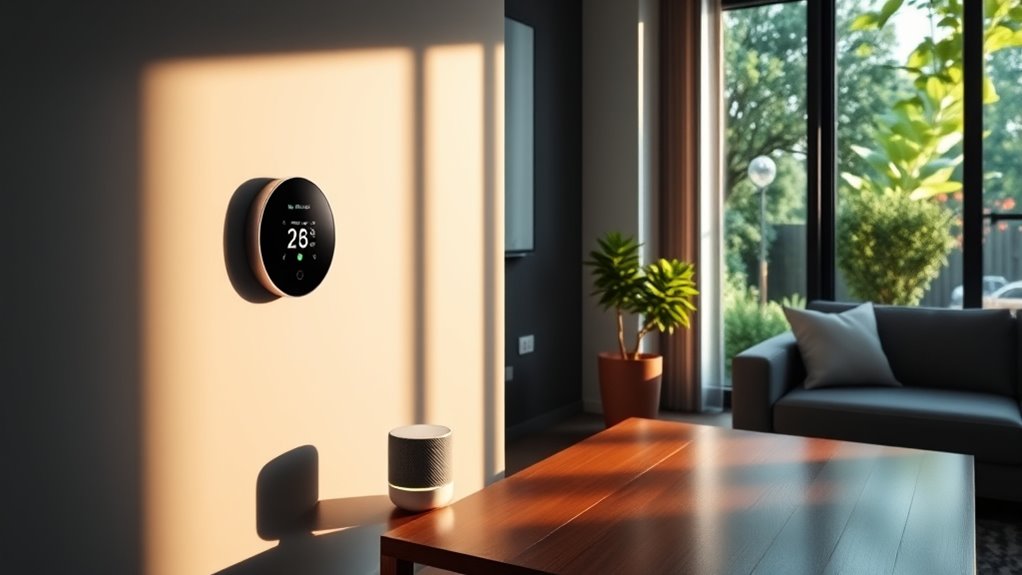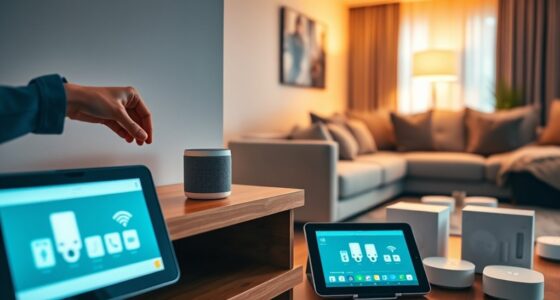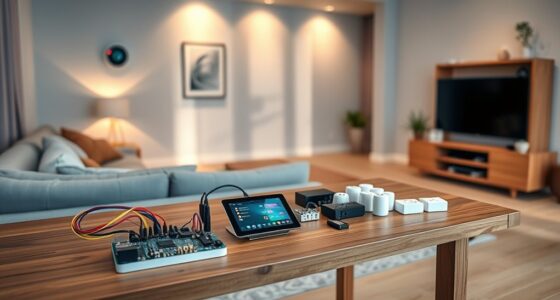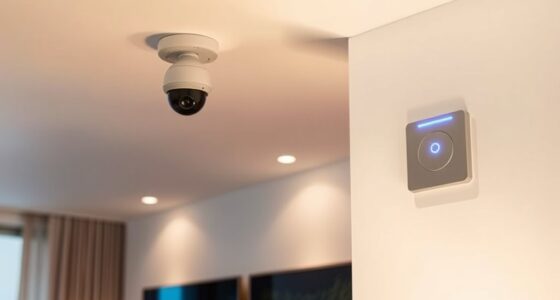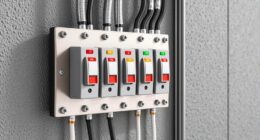To save energy with smart home tech, optimize your thermostat with smart thermostats that learn your schedule and adjust heating or cooling automatically. Use automated lighting with motion sensors and schedules to turn lights off when unoccupied, and monitor device usage with smart plugs to identify high-power appliances. Incorporate renewable energy sources like solar panels, paired with energy storage systems, and set energy-efficient scenes. Keep exploring to discover how these solutions can make your home more eco-friendly and cost-effective.
Key Takeaways
- Use smart thermostats to optimize home heating and cooling, reducing energy waste through automatic adjustments and remote control.
- Automate lighting with sensors and schedules to turn off unused lights and adjust brightness based on occupancy and time of day.
- Monitor device energy consumption with smart plugs to identify high power devices and manage their usage effectively.
- Incorporate renewable energy sources like solar panels and batteries, managed via smart systems for efficient energy storage and usage.
- Set up scenes and routines that automatically control lighting, heating, and appliances to maximize energy savings throughout the day.
How Smart Thermostats Help Reduce Heating and Cooling Costs

Smart thermostats make it easy to cut heating and cooling costs by giving you precise control over your home’s temperature. They optimize energy use by learning your schedule and adjusting settings accordingly. If you have geothermal heating systems, these thermostats can enhance efficiency by syncing with the system’s low-impact energy source. For homes with radiant floor heating, smart thermostats allow you to set specific temperatures for different zones, ensuring comfort without waste. By maintaining consistent temperatures and avoiding unnecessary heating or cooling, you save money on energy bills. Plus, remote access lets you adjust your thermostat from anywhere, preventing energy waste when you’re away. This targeted control helps maximize your system’s lifespan and overall efficiency, making your home more eco-friendly and cost-effective. Incorporating energy-efficient systems and aesthetic decor elements can also help improve the overall energy efficiency of your space.
Automated Lighting Solutions for Energy Efficiency
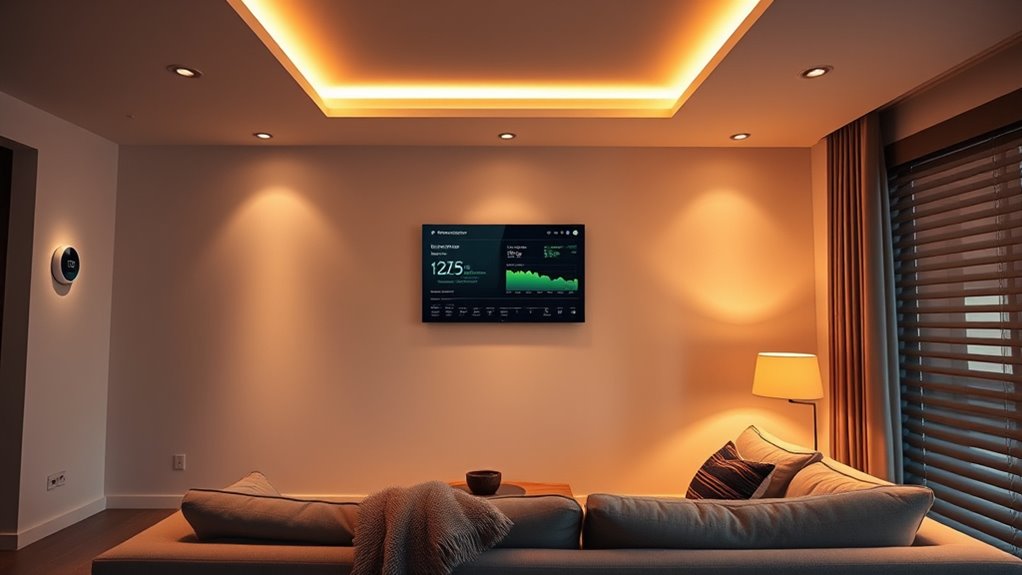
Automated lighting solutions can considerably reduce energy consumption by adapting lighting use to your daily routines and occupancy patterns. With smart systems, lights turn off automatically when rooms are empty and adjust brightness based on the time of day. Imagine walking into a room where color-changing LEDs set the mood, or using voice-controlled lighting to turn on or dim lights effortlessly. You might see:
Automated lighting reduces energy use with smart controls, color-changing LEDs, and voice commands for convenience and efficiency.
- Lights dimming gradually at sunset, saving energy.
- Colors changing based on your mood or activity.
- Voice commands activating lighting without needing to touch switches.
These features not only cut down on wasted energy but also enhance your comfort and convenience. By integrating automated lighting into your smart home, you create an energy-efficient environment tailored to your habits and preferences. Additionally, incorporating sensor technology can further optimize lighting control by accurately detecting occupancy and ambient light levels for even greater efficiency, leveraging advancements in smart home integration. Embracing AI-driven analytics can help you monitor and optimize your lighting usage over time for maximum savings.
Monitoring Your Home’S Energy Use With Smart Plugs
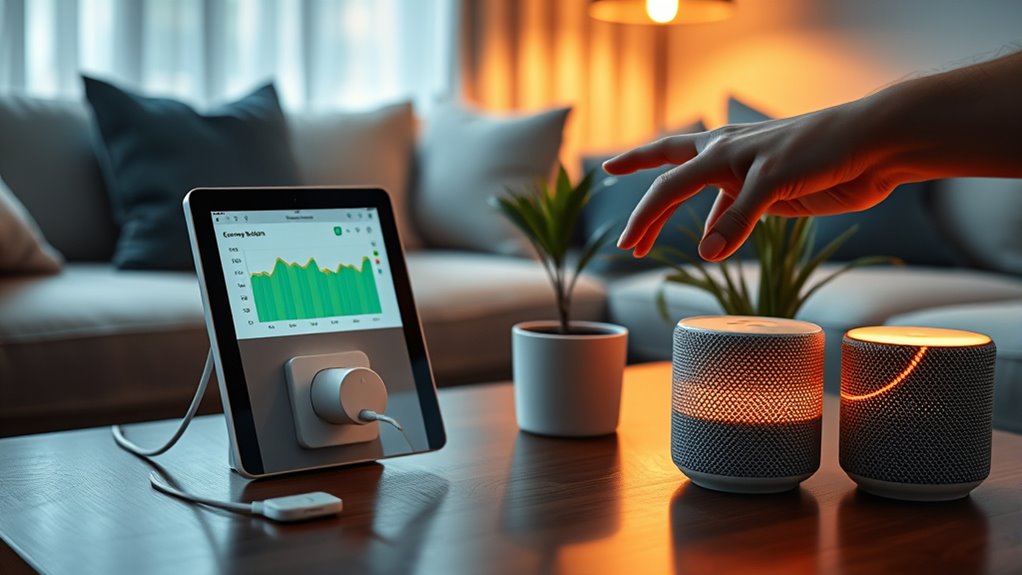
Smart plugs let you see your energy use in real time, so you can spot which devices are wasting power. By identifying your biggest power hogs, you can make smarter decisions about when to turn things off. Automating these savings helps you cut energy costs without sacrificing convenience. Incorporating mind-body awareness techniques can further enhance your understanding of how energy use impacts your overall well-being. Understanding energy consumption patterns enables you to optimize your habits and achieve a healthier balance between technology and personal wellness. Recognizing how nutritional value of juices affects your health can also inform more mindful decisions about your lifestyle. Being aware of headphone maintenance helps ensure your devices function efficiently and last longer, supporting your energy and resource conservation efforts. Regularly monitoring your energy use can also help you notice pore size changes, indicating how your habits impact your skin health.
Real-Time Energy Monitoring
Have you ever wondered how much energy your household appliances actually consume? Real-time energy monitoring with smart plugs makes it easy to find out. By connecting devices to these plugs, you get instant insights into your energy consumption, helping you identify which gadgets use the most power. Imagine seeing live data as lights flicker, appliances hum, or screens glow—giving you a clear picture of your home’s energy habits. With this knowledge, you can optimize your home automation system to reduce waste and save money. Energy consumption data can be displayed on a dashboard that shows colorful graphs, real-time updates, and alerts when appliances draw excessive power. This level of awareness puts control in your hands, making it simple to adjust your routines and maximize energy efficiency effortlessly. Monitoring your home’s energy use can also help you identify energy-hungry devices and take action to improve overall efficiency. Incorporating smart home automation solutions can further enhance your ability to receive timely updates and tips for energy savings.
Identifying Power Hog Devices
Ever wondered which devices in your home are draining the most energy? Smart plugs make it easy to identify power hog devices by monitoring their power consumption. Simply plug your appliances into these devices, and you’ll receive real-time data on how much energy each one uses. This insight helps you pinpoint inefficient devices that may be costing you more than they should. Once you know which items have low device efficiency, you can decide whether to replace, upgrade, or limit their use. Smart plugs provide a clear picture of your home’s energy profile, making it simple to target the biggest energy drainers. Regularly reviewing your energy use can also help you identify spoilage and reduce waste. By actively monitoring power consumption, you take a vital step toward energy conservation and saving money on your energy bills. Additionally, understanding your electrical load can help prevent potential hazards caused by overloaded circuits. Incorporating smart home technology can also facilitate automated energy management, further optimizing your energy use and efficiency. Recognizing peak usage times can help you shift energy-consuming activities to off-peak hours, saving additional costs.
Automating Energy Savings
By automating energy savings with smart plugs, you can continuously monitor your home’s energy use and make smarter decisions to cut costs. These devices enable home automation, giving you real-time energy analytics that reveal exactly how much power your appliances consume. With smart plugs, you can set schedules to turn off devices when not in use or adjust settings remotely, ensuring energy isn’t wasted. Visualize your home with:
- Lights dimming automatically at bedtime
- Coffee makers powering down after brewing
- Chargers stopping once devices are fully charged
This seamless control helps you optimize energy consumption effortlessly. By leveraging smart plugs, you harness the power of home automation and energy analytics to reduce your utility bills and minimize your carbon footprint. Engaging in regular maintenance and understanding energy management can further enhance your savings and efficiency.
Incorporating Solar Power and Energy Storage Systems
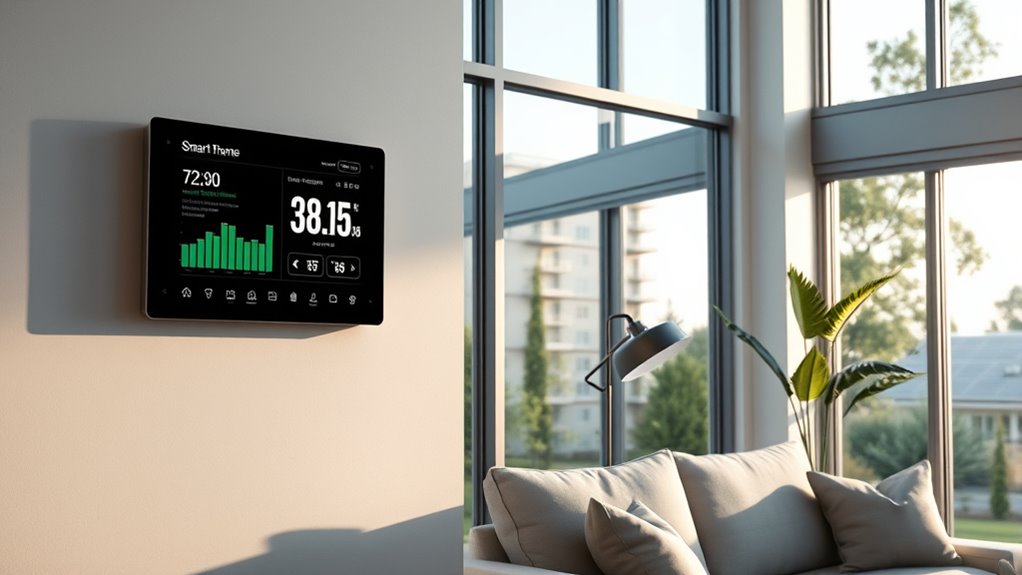
Incorporating solar power and energy storage systems into your smart home can markedly boost energy efficiency and reduce reliance on the grid. Solar panels capture sunlight to generate clean energy, but they require regular solar panel maintenance to guarantee peak performance. Pairing them with energy storage options, like batteries, lets you store excess power for cloudy days or nighttime use. This setup is reminiscent of covert energy covert operations, where maximizing resources is crucial. Utilizing energy storage systems can also help you manage energy demand during peak hours, further reducing costs. This not only maximizes your solar investment but also provides backup during outages. Choosing the right energy storage system depends on your home’s energy needs and budget. By integrating these systems with your smart home tech, you can automatically enhance energy use, cut costs, and lower your carbon footprint. Overall, solar power and storage create a sustainable, efficient energy solution tailored to your lifestyle.
Smart Appliances That Conserve Power
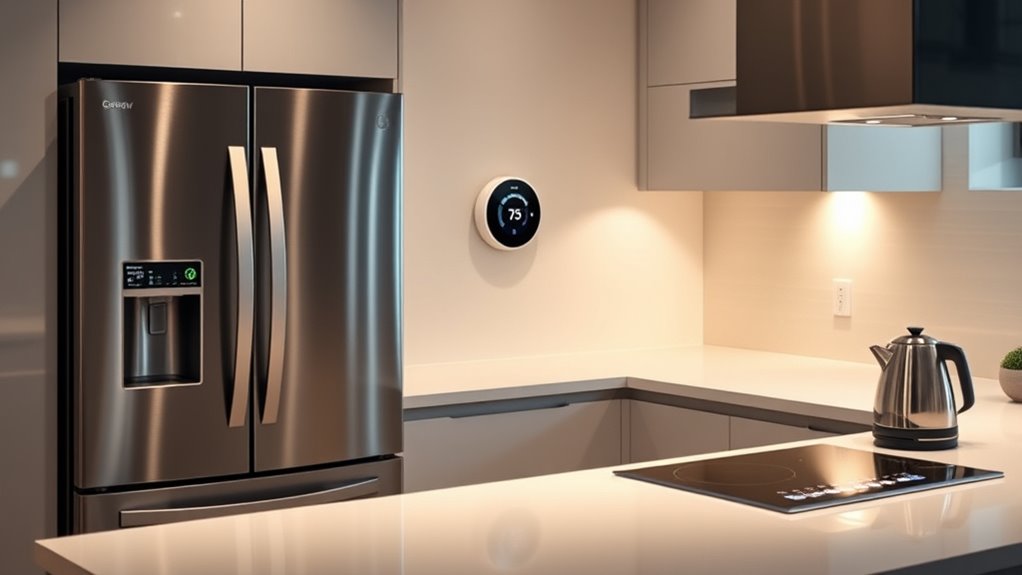
Are you making the most of your appliances to save energy? Smart appliances that conserve power can make a big difference in your home’s efficiency. These devices use advanced technology to optimize energy consumption without sacrificing performance. For example, energy-efficient appliances like refrigerators and washing machines adjust their operation to reduce waste. Smart power strips automatically turn off devices when they’re not in use, preventing phantom loads. Imagine your coffee maker, TV, and chargers all connected to a smart power strip, shutting down when inactive. Visualize a sleek refrigerator that adjusts its cooling based on usage patterns, or a washing machine that only runs when energy costs are lower. These smart appliances help you cut costs and lessen your environmental impact effortlessly.
Using Motion Sensors to Minimize Unnecessary Lighting

Have you ever left a room only to realize the lights stayed on? Motion sensors can fix that by automatically turning off lights when no movement is detected. These sensors detect your presence and activate lighting only when needed, preventing energy waste. They work well with ambient lighting, adjusting brightness based on the room’s conditions, so you don’t sacrifice comfort for savings. Installing motion sensors in hallways, bathrooms, or outdoor areas ensures lights are on only when someone is present. This not only reduces energy consumption but also extends the lifespan of your bulbs. Plus, you don’t have to worry about manually switching lights off, making your home smarter and more energy-efficient. It’s a simple step toward cutting costs and conserving resources effortlessly.
Setting Up Energy-Saving Scenes and Schedules
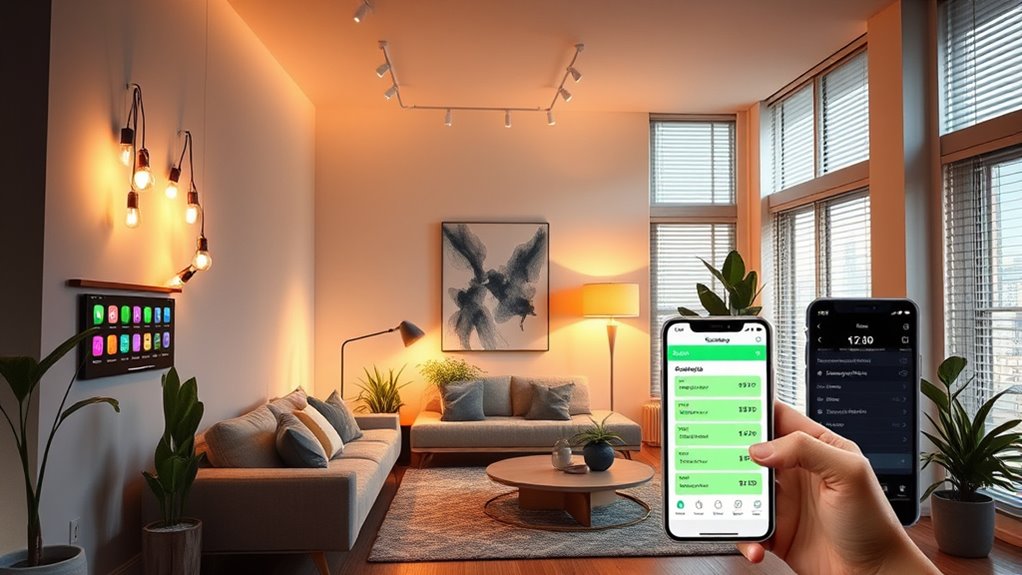
You can conserve energy by automating your lighting schedules and adjusting your thermostat settings to match your daily routines. Customizing device routines ensures your home runs efficiently without manual effort. Setting up these scenes and schedules helps you stay comfortable while reducing unnecessary energy use.
Automate Lighting Schedules
Setting up automated lighting schedules allows you to optimize energy use effortlessly by adjusting lights based on your daily routines. With lighting automation, you can create schedule customization that turns lights off when rooms are empty or dims them during certain hours. This reduces unnecessary energy consumption without sacrificing comfort. Imagine walking into a room where lights turn on automatically as you arrive and turn off when you leave. You can also set lights to gradually brighten in the mornings or dim in the evenings, enhancing ambiance while saving energy. Key features include:
- Lights activating only during specific times
- Dimming presets for different activities
- Motion sensors that trigger lights when movement is detected
Optimize Thermostat Settings
Ever wondered how to make your thermostat work smarter and save more energy? Setting up energy-saving scenes and schedules is the key. Use your smart thermostat to automatically lower the temperature at night or when you’re away, cutting energy use without sacrificing comfort. Adjust humidity control to prevent excess moisture, which can make your home feel cooler or warmer than it is. Improve window insulation to reduce heat exchange, allowing your thermostat to maintain stable indoor temperatures more efficiently. Imagine this:
| Home State | Thermostat Setting | Humidity Level |
|---|---|---|
| Daytime | 72°F, Comfort Mode | 40-50% |
| Night | 65°F, Sleep Mode | 40-50% |
| Away | 60°F, Eco Mode | 30-40% |
This setup maximizes energy savings while keeping your home comfortable.
Customize Device Routines
Creating energy-saving scenes and schedules with your smart home devices allows you to automate routines that reduce energy consumption without sacrificing comfort. By setting up custom routines and personalizing devices, you guarantee your home adapts to your lifestyle seamlessly. Imagine waking up to your lights gradually dimming, your thermostat adjusting to a comfortable temperature, and appliances powering down when not in use—all automatically. With device personalization, you can create specific scenes for different times of day or activities, optimizing energy use effortlessly. This proactive approach not only conserves energy but also enhances convenience. Think of it as tailoring your smart home’s behavior to fit your habits perfectly, making energy efficiency an integral part of your daily life.
Tips for Integrating Renewable Energy With Smart Home Technology
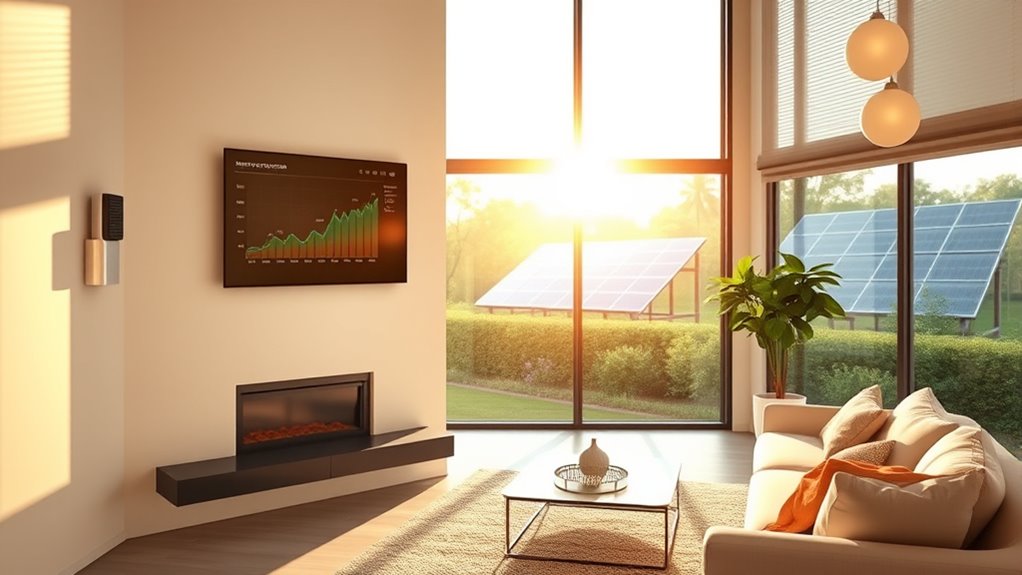
Integrating renewable energy sources into your smart home can substantially boost your energy efficiency and reduce costs. Start by exploring solar integration, which allows your smart system to optimize solar panel output and store excess energy in batteries. Automated controls can adjust your energy consumption based on sunlight availability, maximizing savings. Wind power is another option if you live in a suitable area; smart home tech can monitor wind conditions and manage small-scale turbines efficiently. Connect your renewable sources to your home’s energy management system for real-time monitoring and seamless operation. By integrating solar and wind power with your smart home, you create a more sustainable setup that reduces reliance on the grid and lowers your energy bills.
Frequently Asked Questions
Can Smart Home Devices Really Lower My Energy Bills Significantly?
Smart home devices can definitely lower your energy bills by reducing your energy consumption. They allow you to automate and optimize heating, cooling, and lighting, so you’re not wasting energy when you’re not home or asleep. With these tools, you’ll see real cost savings over time, as you use energy more efficiently. Plus, many devices provide insights that help you make smarter choices about your energy use, further cutting costs.
Are Smart Home Energy Systems Compatible With Existing Appliances?
Did you know that over 60% of smart home energy systems are compatible with most existing setups? When it comes to your legacy appliances, compatibility issues can arise, but many modern systems are designed for easy integration. Before buying, check the product specifications and consult with manufacturers to verify your appliances will work seamlessly. This way, you can optimize energy savings without needing to replace all your appliances.
How Secure Are Smart Home Energy Management Systems From Hacking?
Smart home energy management systems face cybersecurity risks, so you should stay vigilant. While they use encryption and secure protocols, hackers can exploit vulnerabilities if you don’t keep software updated. Your data privacy is also at stake, as sensitive energy usage info could be accessed. To protect yourself, regularly update firmware, change default passwords, and enable two-factor authentication, ensuring your system stays secure from potential hacking threats.
What Is the Average Lifespan of Smart Energy-Saving Devices?
You might be surprised to learn that smart energy-saving devices typically last around 8-10 years. Their device durability depends on factors like build quality and usage patterns, while maintenance requirements can extend their lifespan. Regular updates and careful handling help prevent early failures. If you stay on top of these aspects, your smart devices can reliably save energy and serve you well for many years.
Do Smart Home Energy Solutions Require Professional Installation?
You might wonder if smart home energy solutions need professional installation. Many devices now support DIY installation, making it easier for you to set up. Just make certain device compatibility with your existing systems before starting. While some advanced setups may require expert help, most smart energy-saving devices are designed for simple installation, empowering you to enhance your home’s efficiency without the need for professional assistance.
Conclusion
Smart home tech transforms your space into a sustainable sanctuary. By blending brilliant bulbs, smart sensors, and solar solutions, you can save energy effortlessly. Embrace eco-friendly innovations to enhance efficiency, lower costs, and live smarter. Start small, stay savvy, and see the significant savings grow. With these simple steps, you’ll power down waste and power up sustainability, proving that a greener home begins with your smart choices. Make mindful moves today for a brighter, better tomorrow.

